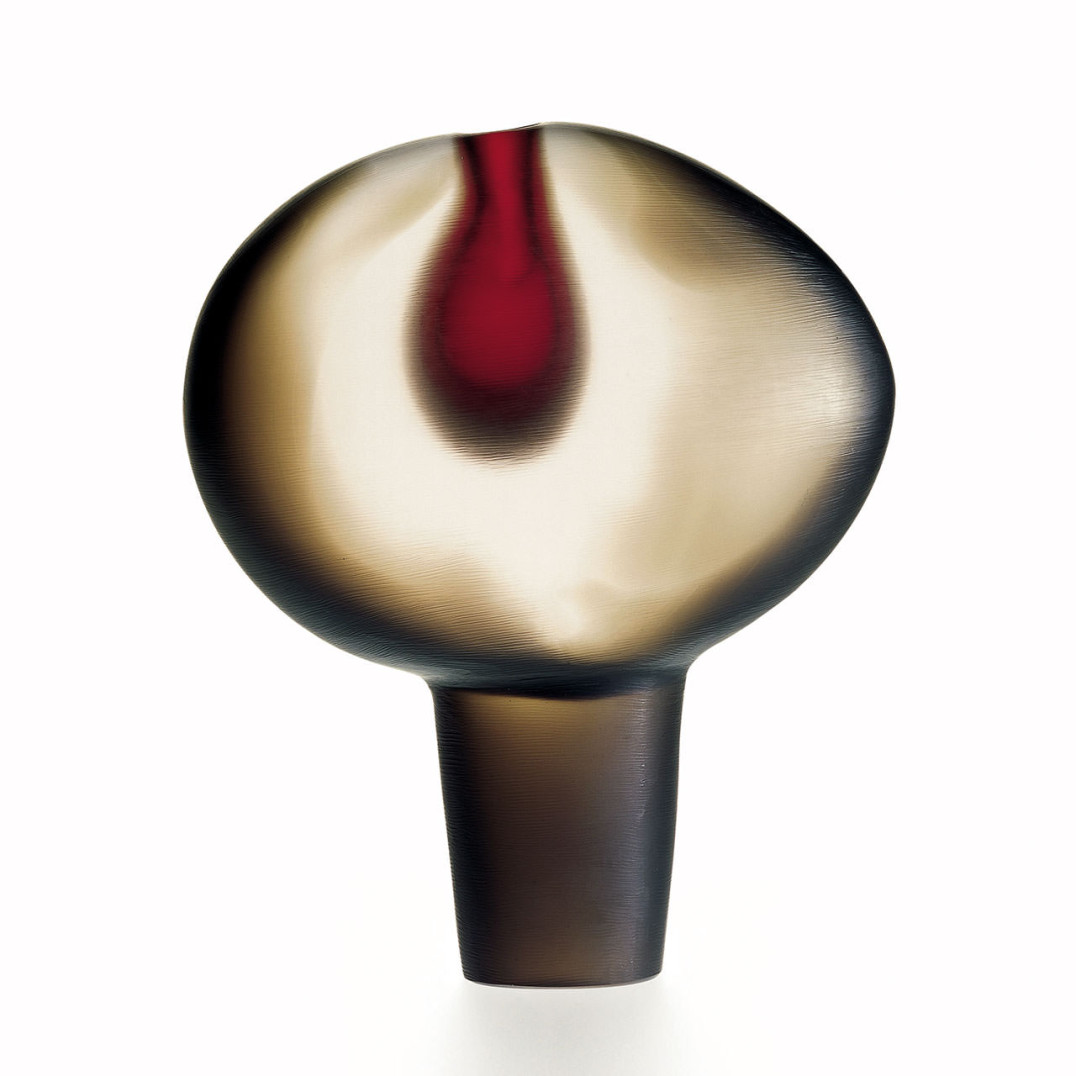
Alfredo BarbiniVetro pesante, 1962

Alfredo BarbiniVetro pesanteVetreria Alfredo Barbini, 1962
Sculptural vessel in pesante, heavy glass, sommerso in several layers of glass. The core of the sculpture is red, the finish a tight wheel-carved horizontal inciso.
10 1/2 in. high (26.7 cm)
Exhibitions:
1962, Venice, 31st Biennale Internazionale d’Arte;
2000, New York, Venetian Glass, Museum of Arts & Design;
2001, Milan, Murano: Vetri dalla Collezione Olnick Spanu, Spazio Oberdan.
Bibliography and comparative texts:
Catalogue 31st Biennale…, 1962, n. 210;
Mille anni…, 1982, n. 571;
M. Heiremans, 1989, n. 30;
M. Cocchi, 1991, n. 49;
M. Heiremans, 1993, n. 17;
M. Barovier, R. Barovier Mentasti,
A. Dorigato, 1995, n. 134;
M. Heiremans, 1996, n. 213;
H. Ricke, E. Schmitt, 1996, n. 252;
M. Barovier, 1999, p. 243;
Olnick Spanu, 2000, n. 133;
Olnick Spanu, 2001, n. 168;
A. Dorigato, 2002, p. 335.
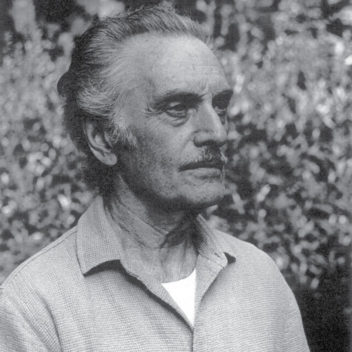
Alfredo Barbini 1912–2006
Glassblower, designer, and entrepreneur Alfredo Barbini was born in Murano and began working with glass while very young. At seventeen and a half, following a brief apprenticeship, he became a glass maestro; first at the Cristalleria Franchetti and then at the S.A.I.A.R. Ferro Toso. After 1932, he worked at the Zecchin-Martinuzzi furnace with the sculptor Napoleone Martinuzzi, and began a collaboration that would last through 1936. This would prove to be fundamental to his artistic development, especially in regard to sculpture in solid massiccio glass. In 1937, he became a partner at V.A.M.S.A. and was the primo maestro of the main team of the furnace continuing his experimentation with thick glass and executing works designed by the artists Ermenegildo Ripa and Luigi Scarpa Croce. In 1946, he became partner and artistic director of the new furnace Gino Cenedese & C. With this furnace, he participated in the 1948 Biennale di Venezia, exhibiting a remarkable series of sculptures in corroso glass such as Torso and Collasso. In 1950, he opened his own furnace, Vetreria Alfredo Barbini, where he continued to experiment with the sculptural qualities of glass using materials and forms that are more and more essential. This can be seen in his series Pesci and Tulipani or in the Vetri Pesanti of the early '60s. Assisted by his son Flavio since 1968, Barbini continued working for several decades as maestro and artistic director of the furnace he created in 1950.
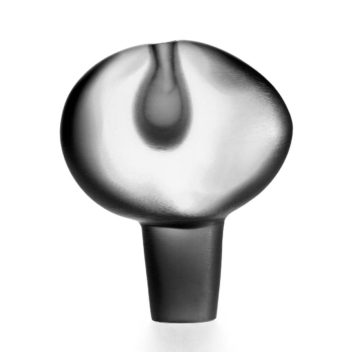
Vetreria Alfredo Barbini 1932–
Alfredo Barbini worked as an apprentice at S.A.I.A.R. Ferro Toso and the Società Anonima Vetrerie e Cristallerie di Murano. He also worked as a glassblower in furnaces such as Barovier Seguso & Ferro, V.A.M.S.A., and in particular, Gino Cenedese & C., where he served as the artistic director. In 1950, Barbarini opened his own furnace. Skilled in the hot-work manipulation of massiccio glass, to Barbini channeled his efforts towards researching the malleability of glass, as his preference for essential forms continued to grow. After the '60s, Flavio Barbini joined his father in both the administration of the company and product design. Today, the company is still one of the most important glassmakers in Murano.
Alfredo BarbiniVetro pesante, 1962
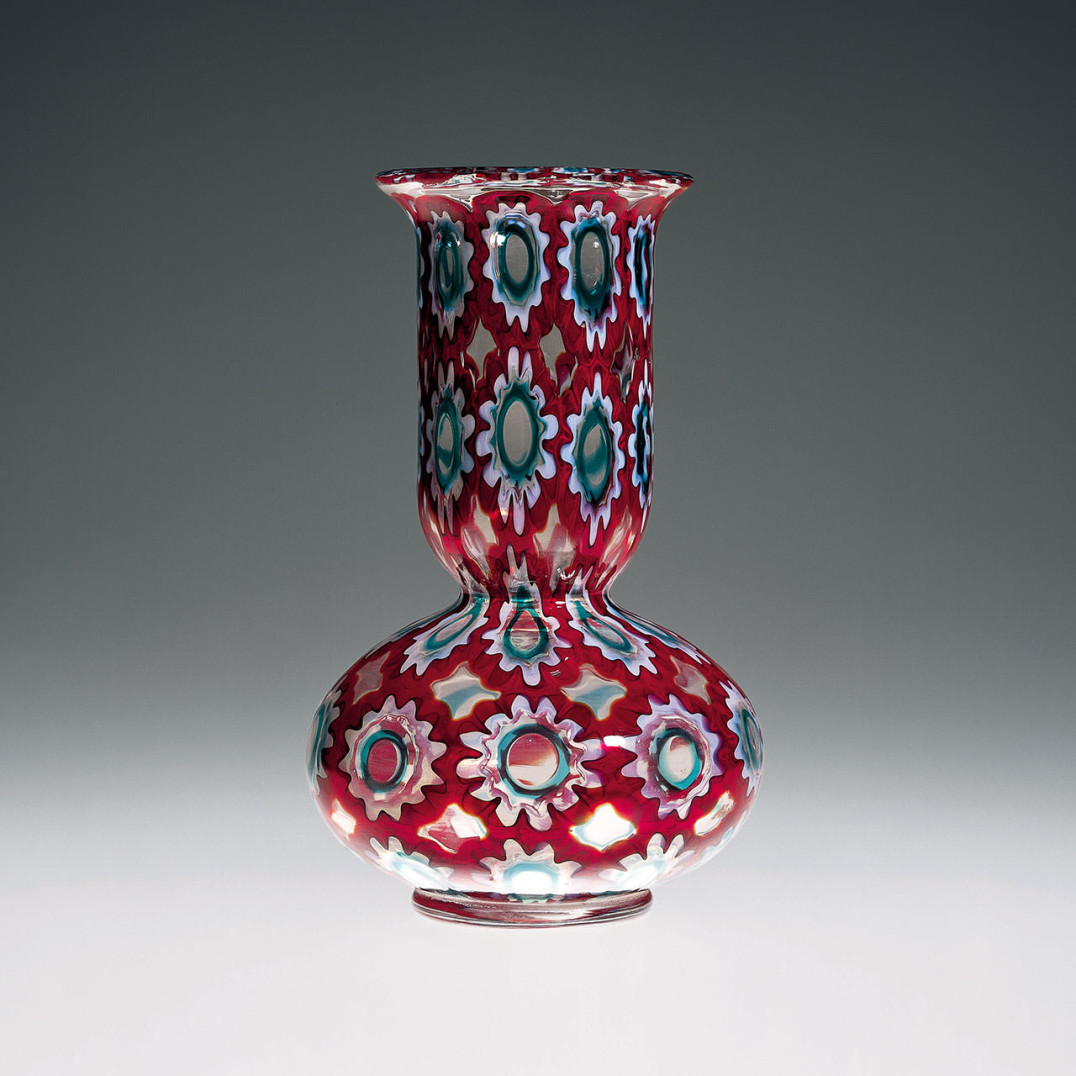
Ercole BarovierRotellato, 1970
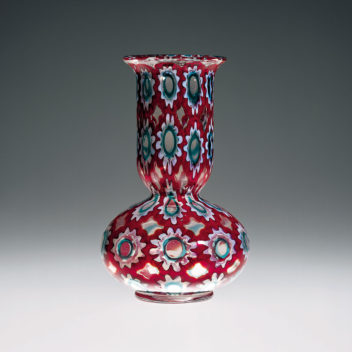
Ercole BarovierRotellatoBarovier & Toso, 1970
A footed vase composed of circular tessere a dentelli, with indentations in cristallo, blue, and red glass.
11 in. high (28 cm)
Exhibitions:
1970, Venice, 35th Biennale Internazionale d’Arte;
2000, New York, Venetian Glass, Museum of Arts & Design;
2001, Milan, Murano: Vetri dalla Collezione Olnick Spanu, Spazio Oberdan.
Bibliography and comparative texts:
A. Dorigato, 1989, n. 117;
M. Barovier, 1993, nn. 178, 179;
M. Barovier, R. Barovier Mentasti,
A. Dorigato 1995, n. 184;
F. Deboni, 1996, n. 50;
M. Heiremans, 1996, n. 255;
M. Barovier, 1999, p. 277;
Olnick Spanu, 2000, n. 132;
Olnick Spanu, 2001, n. 167.
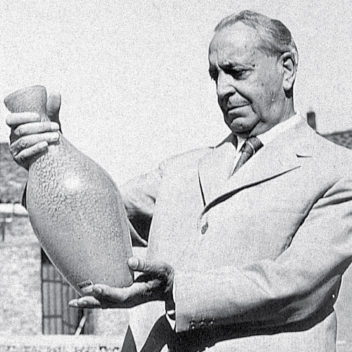
Ercole Barovier 1889–1974
Entrepreneur and designer Ercole Barovier was the son of Benvenuto Barovier. At age 30, he became a partner in his father's company, the Vetreria Artistica Barovier & C. After becoming its artistic director in 1926, he took over its management with his brother. He became sole proprietor in 1936, engineering the fusion between his own glass workshop and the S.A.I.A.R. Ferro-Toso. In 1942, the new company was renamed Barovier & Toso and Ercole maintained artistic direction until 1972. His first major successes date back to the '20s; first with the murrine vessels, then with totally original creations such as the Primavera glass collection of 1929-30. After the 30s, he dedicated himself entirely to experimenting with new multi-colored effects. In addition he perfected the colorazione a caldo senza fusione which he first used in 1935-36 to create the series Crepuscolo, Autunno Gemmato, Marina Gemmata, and Laguna Gemmata. Before World War II, he preferred soft shapes and rather thick materials, whereas in the postwar period his interest turned specifically to the field of traditional techniques, which he continued to reinterpret through his very last creations with the series A Tessere in 1972. In the '50s, his work distinguished itself, both for the vivid quality of its colors as well as for the singularity of the materials noted for the rawness of their surfaces like the barbarici. During the '60s and '70s, he gave new interpretations of his a tessere glass with the Dorici, Caccia, Rotellati, and other series, which were characterized by unusual color combinations.
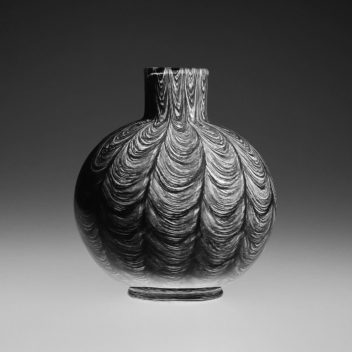
Barovier & Toso 1942–
In 1936, Ercole Barovier became partner of the S.A.I.A.R. Ferro Toso, forming Ferro Toso e Barovier. In 1939, it became Barovier Toso & C., and finally, in 1942, its name was changed to Barovier & Toso. Ercole Barovier remained artistic director of the company through 1972 and was succeeded by his son, Angelo, who was already a designer for the company. Beginning in the '80s and continuing through today, many have designers collaborated with Barovier & Toso. Among them are Matteo Thun, Toni Zuccheri, Renato and Giusto Toso, and Noti Massari. The company’s most recent productions have been created by designers like Roberto Caddeo, Marco Mencacci, Franco Raggi, Luca Scacchetti, and others. Barovier & Toso is currently directed by Angelo, his son Jacopo, and Giovanni Toso.
Ercole BarovierRotellato, 1970
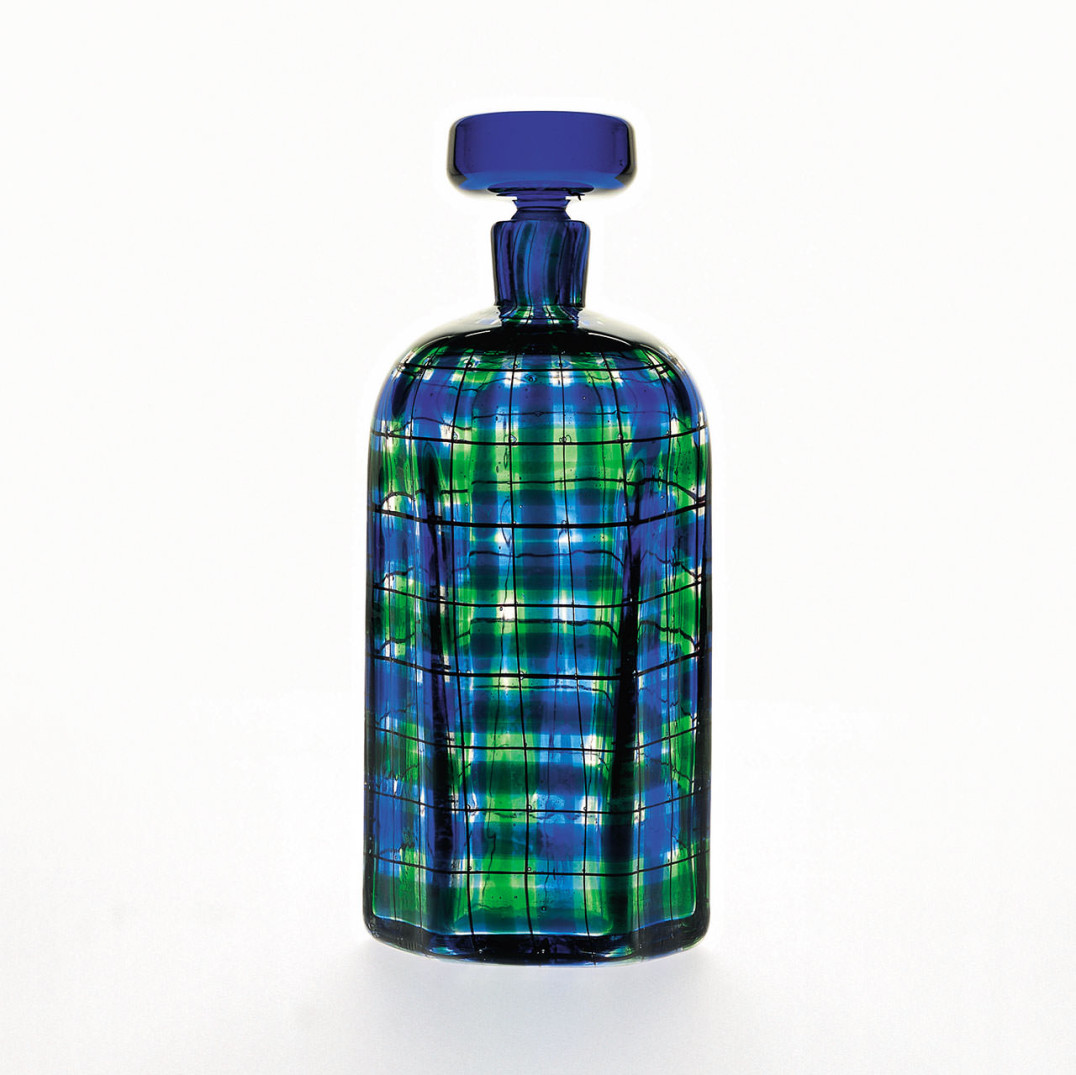
Ercole BarovierChristian Dior, 1969
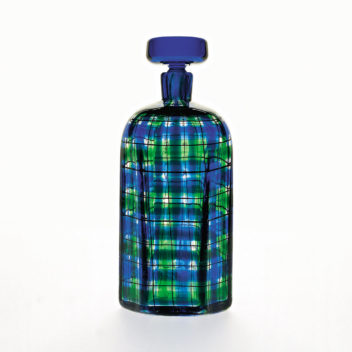
Ercole BarovierChristian DiorBarovier & Toso, 1969
Stoppered decanter in a Scottish plaid pattern. The design was achieved by intersecting canes of blue and cristallo glass with canes of green and cristallo. This very limited series was originally produced for the French clothing designer Christian Dior.
Engraved: Christian Dior.
9 9/16 in. high (24.3 cm)
Exhibitions:
2000, New York, Venetian Glass, Museum of Arts & Design;
2001, Milan, Murano: Vetri dalla Collezione Olnick Spanu, Spazio Oberdan.
Bibliography and comparative texts:
M. Barovier, 1993, n. 177;
F. Deboni, 1996, n. 57;
H. Ricke, E. Schmitt, 1996, n. 269;
Olnick Spanu, 2000, n. 131;
Olnick Spanu, 2001, n. 166.

Ercole Barovier 1889–1974
Entrepreneur and designer Ercole Barovier was the son of Benvenuto Barovier. At age 30, he became a partner in his father's company, the Vetreria Artistica Barovier & C. After becoming its artistic director in 1926, he took over its management with his brother. He became sole proprietor in 1936, engineering the fusion between his own glass workshop and the S.A.I.A.R. Ferro-Toso. In 1942, the new company was renamed Barovier & Toso and Ercole maintained artistic direction until 1972. His first major successes date back to the '20s; first with the murrine vessels, then with totally original creations such as the Primavera glass collection of 1929-30. After the 30s, he dedicated himself entirely to experimenting with new multi-colored effects. In addition he perfected the colorazione a caldo senza fusione which he first used in 1935-36 to create the series Crepuscolo, Autunno Gemmato, Marina Gemmata, and Laguna Gemmata. Before World War II, he preferred soft shapes and rather thick materials, whereas in the postwar period his interest turned specifically to the field of traditional techniques, which he continued to reinterpret through his very last creations with the series A Tessere in 1972. In the '50s, his work distinguished itself, both for the vivid quality of its colors as well as for the singularity of the materials noted for the rawness of their surfaces like the barbarici. During the '60s and '70s, he gave new interpretations of his a tessere glass with the Dorici, Caccia, Rotellati, and other series, which were characterized by unusual color combinations.

Barovier & Toso 1942–
In 1936, Ercole Barovier became partner of the S.A.I.A.R. Ferro Toso, forming Ferro Toso e Barovier. In 1939, it became Barovier Toso & C., and finally, in 1942, its name was changed to Barovier & Toso. Ercole Barovier remained artistic director of the company through 1972 and was succeeded by his son, Angelo, who was already a designer for the company. Beginning in the '80s and continuing through today, many have designers collaborated with Barovier & Toso. Among them are Matteo Thun, Toni Zuccheri, Renato and Giusto Toso, and Noti Massari. The company’s most recent productions have been created by designers like Roberto Caddeo, Marco Mencacci, Franco Raggi, Luca Scacchetti, and others. Barovier & Toso is currently directed by Angelo, his son Jacopo, and Giovanni Toso.
Ercole BarovierChristian Dior, 1969
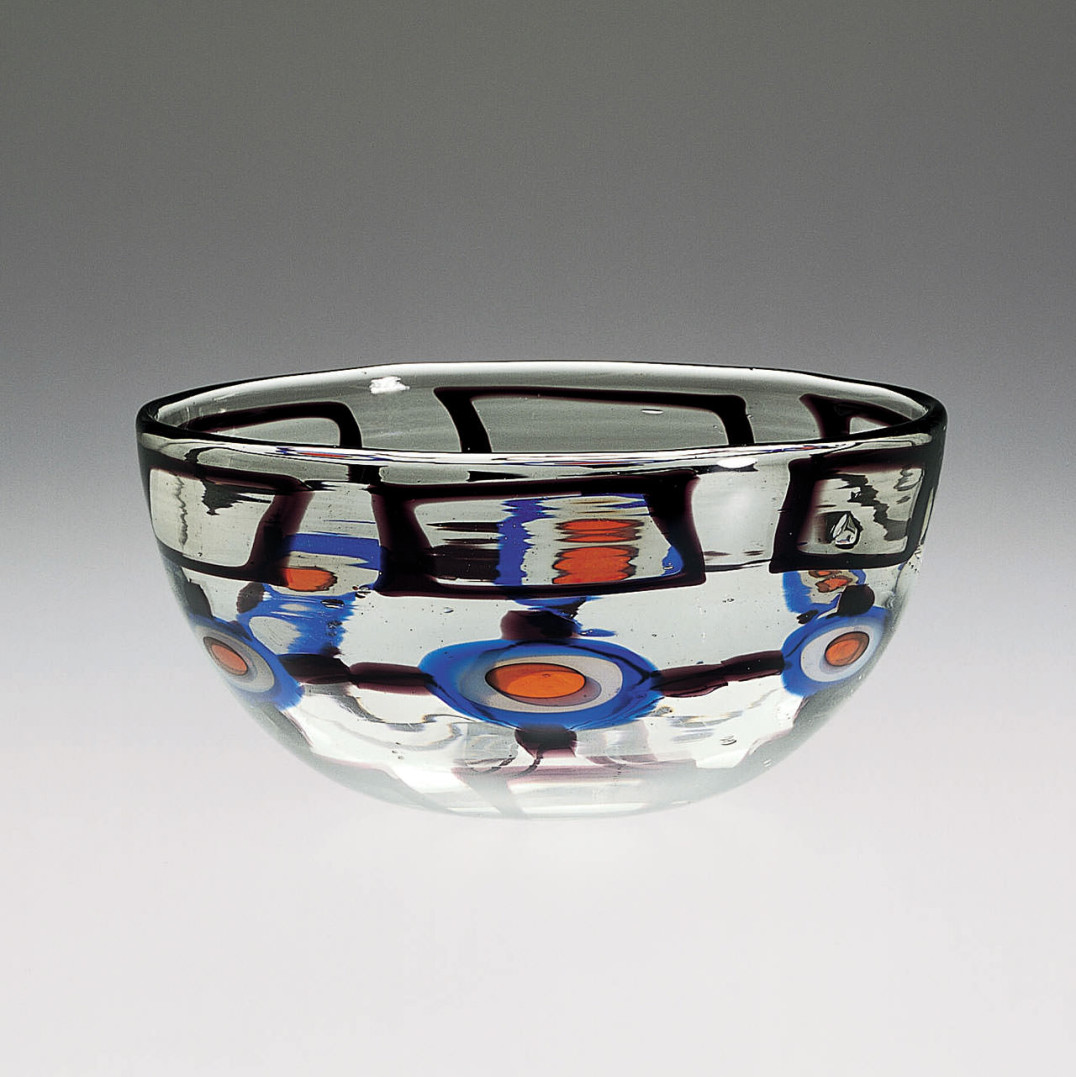
Ercole BarovierTessere policrome, 1962
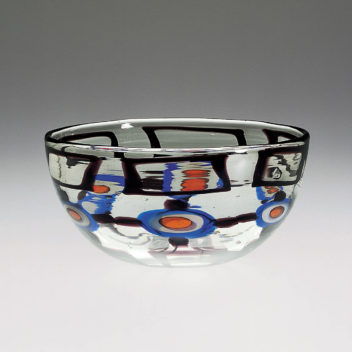
Ercole BarovierTessere policromeBarovier & Toso, 1962
Bowl composed of cristallo tessere. The top portion is a band of rectangular tessere outlined in aubergine; the lower portion is composed of circular murrine in red, lattimo, and blue connected by
an aubergine line.
Engraved: Ercole Barovier 2/11/62.
3 5/8 in. high (9.3 cm)
Ø; 7 1/2 in. (19 cm)
Exhibitions:
1993, Venice, L’Arte dei Barovier Vetrai di Murano 1866-1972,
Querini Stampalia;
2000, New York, Venetian Glass, Museum of Arts & Design;
2001, Milan, Murano: Vetri dalla Collezione Olnick Spanu, Spazio Oberdan.
Bibliography and comparative texts:
M. Barovier, 1993, n. 164;
H. Ricke, E. Schmitt, 1996, n. 268;
Olnick Spanu, 2000, n. 130;
Olnick Spanu, 2001, n. 165.

Ercole Barovier 1889–1974
Entrepreneur and designer Ercole Barovier was the son of Benvenuto Barovier. At age 30, he became a partner in his father's company, the Vetreria Artistica Barovier & C. After becoming its artistic director in 1926, he took over its management with his brother. He became sole proprietor in 1936, engineering the fusion between his own glass workshop and the S.A.I.A.R. Ferro-Toso. In 1942, the new company was renamed Barovier & Toso and Ercole maintained artistic direction until 1972. His first major successes date back to the '20s; first with the murrine vessels, then with totally original creations such as the Primavera glass collection of 1929-30. After the 30s, he dedicated himself entirely to experimenting with new multi-colored effects. In addition he perfected the colorazione a caldo senza fusione which he first used in 1935-36 to create the series Crepuscolo, Autunno Gemmato, Marina Gemmata, and Laguna Gemmata. Before World War II, he preferred soft shapes and rather thick materials, whereas in the postwar period his interest turned specifically to the field of traditional techniques, which he continued to reinterpret through his very last creations with the series A Tessere in 1972. In the '50s, his work distinguished itself, both for the vivid quality of its colors as well as for the singularity of the materials noted for the rawness of their surfaces like the barbarici. During the '60s and '70s, he gave new interpretations of his a tessere glass with the Dorici, Caccia, Rotellati, and other series, which were characterized by unusual color combinations.

Barovier & Toso 1942–
In 1936, Ercole Barovier became partner of the S.A.I.A.R. Ferro Toso, forming Ferro Toso e Barovier. In 1939, it became Barovier Toso & C., and finally, in 1942, its name was changed to Barovier & Toso. Ercole Barovier remained artistic director of the company through 1972 and was succeeded by his son, Angelo, who was already a designer for the company. Beginning in the '80s and continuing through today, many have designers collaborated with Barovier & Toso. Among them are Matteo Thun, Toni Zuccheri, Renato and Giusto Toso, and Noti Massari. The company’s most recent productions have been created by designers like Roberto Caddeo, Marco Mencacci, Franco Raggi, Luca Scacchetti, and others. Barovier & Toso is currently directed by Angelo, his son Jacopo, and Giovanni Toso.
Ercole BarovierTessere policrome, 1962
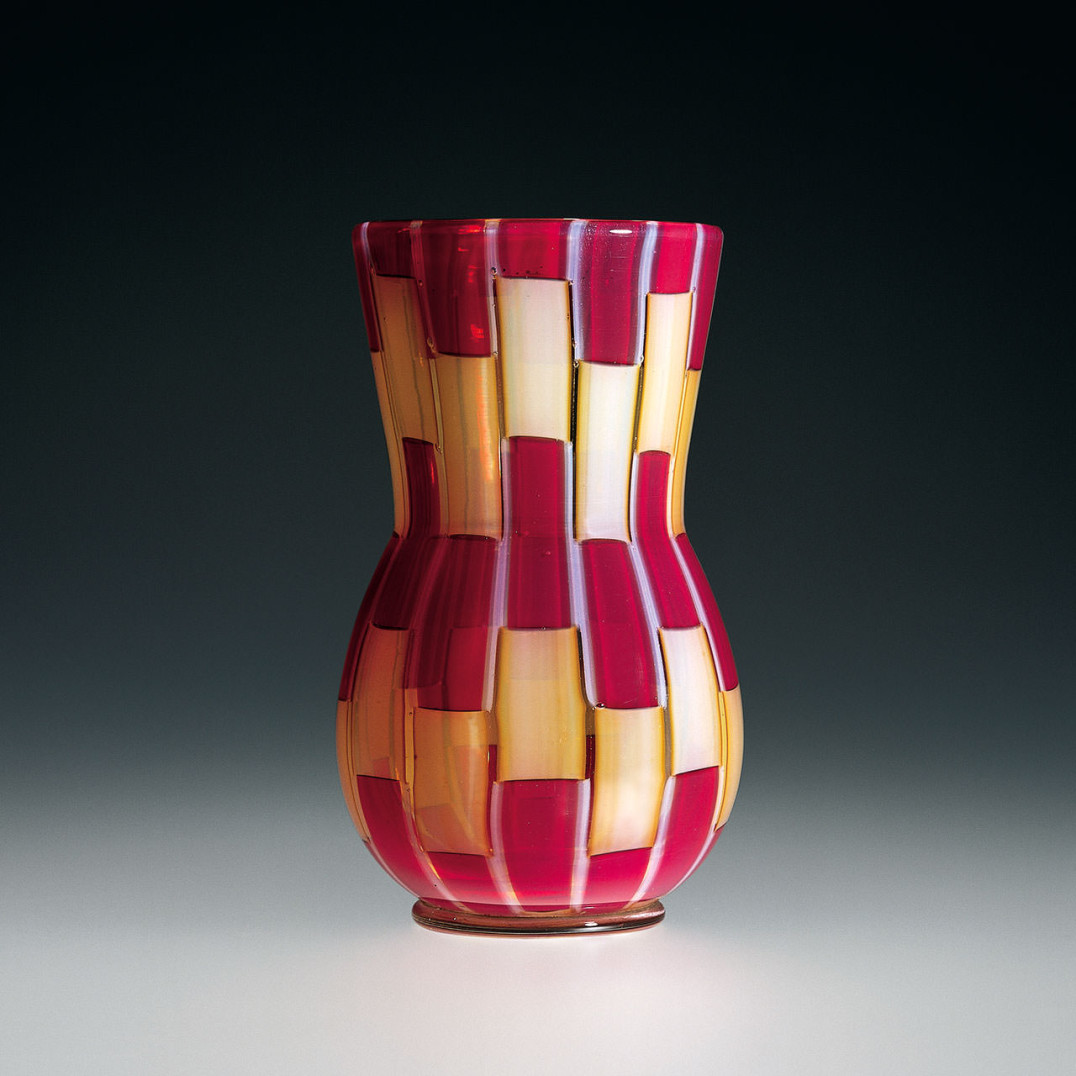
Ercole BarovierPezzato, 1956
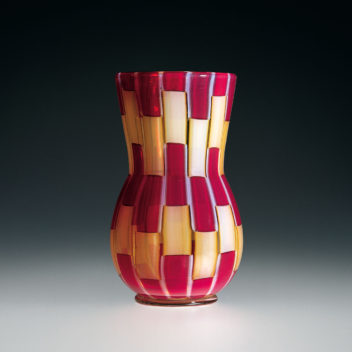
Ercole BarovierPezzatoBarovier & Toso, 1956
Glass vessel crafted with the use
of red and lattimo patches of glass, sommersi in opaline glass.
10 in. high (25.4 cm)
Exhibitions:
1993, Venice, L’Arte dei Barovier Vetrai di Murano 1866-1972,
Querini Stampalia;
2000, New York, Venetian Glass, Museum of Arts & Design;
2001, Milan, Murano: Vetri dalla Collezione Olnick Spanu, Spazio Oberdan.
Bibliography and comparative texts:
A. Dorigato, 1989, p. 139;
M. Heiremans, 1989, n. 52;
M. Barovier, 1993, p. 171;
F. Deboni, 1996, n. 53;
M. Heiremans, 1996, nn. 160, 161;
Olnick Spanu, 2000, n. 126;
Olnick Spanu, 2001, n. 164.
Glass vase composed of green, cristallo, and amethyst glass patches arranged in a herringbone pattern.
9 in. high (23 cm)
Bibliography and comparative texts:
R. Linzeler, 1922, p. 666;
C. Carrà , 1923, p. 67;
R. Linzeler, 1923, p. 83;
R. Papini, 1930, n. 570;
G. Mariacher, 1967, p. 98;
R. Barovier Mentasti, 1982, n. 252;
Mille anni…, 1982, n. 503;
F. Deboni, 1984, p. n. 70;
W. Neuwirth, 1987, nn. 7, 104;
A. Dorigato, 1986,
p. 71;
F. Deboni, 1989, n. 1;
L’arte del vetro, 1982, n. 307;
M. Heiremans, 1993, n. 191;
M. Barovier, R. Barovier Mentasti,
A. Dorigato, 1995, n. 15;
A. Venini Diaz de Santillana, 1996, n. 1;
R. Barovier Mentasti, 1998, n. 25;
A. Venini Diaz de Santillana, 2000, n. 1;
Olnick Spanu, 2000, n. 8;
Olnick Spanu, 2001, n. 13.
Vase composed of grey and red triangular shaped transparent glass patches sommersi in cristallo.
12 in. high (30 cm)
Bibliography and comparative texts:
R. Linzeler, 1922, p. 666;
C. Carrà , 1923, p. 67;
R. Linzeler, 1923, p. 83;
R. Papini, 1930, n. 570;
G. Mariacher, 1967, p. 98;
R. Barovier Mentasti, 1982, n. 252;
Mille anni…, 1982, n. 503;
F. Deboni, 1984, p. n. 70;
W. Neuwirth, 1987, nn. 7, 104;
A. Dorigato, 1986,
p. 71;
F. Deboni, 1989, n. 1;
L’arte del vetro, 1982, n. 307;
M. Heiremans, 1993, n. 191;
M. Barovier, R. Barovier Mentasti,
A. Dorigato, 1995, n. 15;
A. Venini Diaz de Santillana, 1996, n. 1;
R. Barovier Mentasti, 1998, n. 25;
A. Venini Diaz de Santillana, 2000, n. 1;
Olnick Spanu, 2000, n. 8;
Olnick Spanu, 2001, n. 13.
Cylindrical vase composed of two alternating glass bands. One band is made of circular cristallo, lattimo and blue tessere, the other is Diamond-shaped cristallo and black tessere.
9 in. high (23 cm)
Bibliography and comparative texts:
R. Linzeler, 1922, p. 666;
C. Carrà , 1923, p. 67;
R. Linzeler, 1923, p. 83;
R. Papini, 1930, n. 570;
G. Mariacher, 1967, p. 98;
R. Barovier Mentasti, 1982, n. 252;
Mille anni…, 1982, n. 503;
F. Deboni, 1984, p. n. 70;
W. Neuwirth, 1987, nn. 7, 104;
A. Dorigato, 1986,
p. 71;
F. Deboni, 1989, n. 1;
L’arte del vetro, 1982, n. 307;
M. Heiremans, 1993, n. 191;
M. Barovier, R. Barovier Mentasti,
A. Dorigato, 1995, n. 15;
A. Venini Diaz de Santillana, 1996, n. 1;
R. Barovier Mentasti, 1998, n. 25;
A. Venini Diaz de Santillana, 2000, n. 1;
Olnick Spanu, 2000, n. 8;
Olnick Spanu, 2001, n. 13.

Ercole Barovier 1889–1974
Entrepreneur and designer Ercole Barovier was the son of Benvenuto Barovier. At age 30, he became a partner in his father's company, the Vetreria Artistica Barovier & C. After becoming its artistic director in 1926, he took over its management with his brother. He became sole proprietor in 1936, engineering the fusion between his own glass workshop and the S.A.I.A.R. Ferro-Toso. In 1942, the new company was renamed Barovier & Toso and Ercole maintained artistic direction until 1972. His first major successes date back to the '20s; first with the murrine vessels, then with totally original creations such as the Primavera glass collection of 1929-30. After the 30s, he dedicated himself entirely to experimenting with new multi-colored effects. In addition he perfected the colorazione a caldo senza fusione which he first used in 1935-36 to create the series Crepuscolo, Autunno Gemmato, Marina Gemmata, and Laguna Gemmata. Before World War II, he preferred soft shapes and rather thick materials, whereas in the postwar period his interest turned specifically to the field of traditional techniques, which he continued to reinterpret through his very last creations with the series A Tessere in 1972. In the '50s, his work distinguished itself, both for the vivid quality of its colors as well as for the singularity of the materials noted for the rawness of their surfaces like the barbarici. During the '60s and '70s, he gave new interpretations of his a tessere glass with the Dorici, Caccia, Rotellati, and other series, which were characterized by unusual color combinations.

Barovier & Toso 1942–
In 1936, Ercole Barovier became partner of the S.A.I.A.R. Ferro Toso, forming Ferro Toso e Barovier. In 1939, it became Barovier Toso & C., and finally, in 1942, its name was changed to Barovier & Toso. Ercole Barovier remained artistic director of the company through 1972 and was succeeded by his son, Angelo, who was already a designer for the company. Beginning in the '80s and continuing through today, many have designers collaborated with Barovier & Toso. Among them are Matteo Thun, Toni Zuccheri, Renato and Giusto Toso, and Noti Massari. The company’s most recent productions have been created by designers like Roberto Caddeo, Marco Mencacci, Franco Raggi, Luca Scacchetti, and others. Barovier & Toso is currently directed by Angelo, his son Jacopo, and Giovanni Toso.